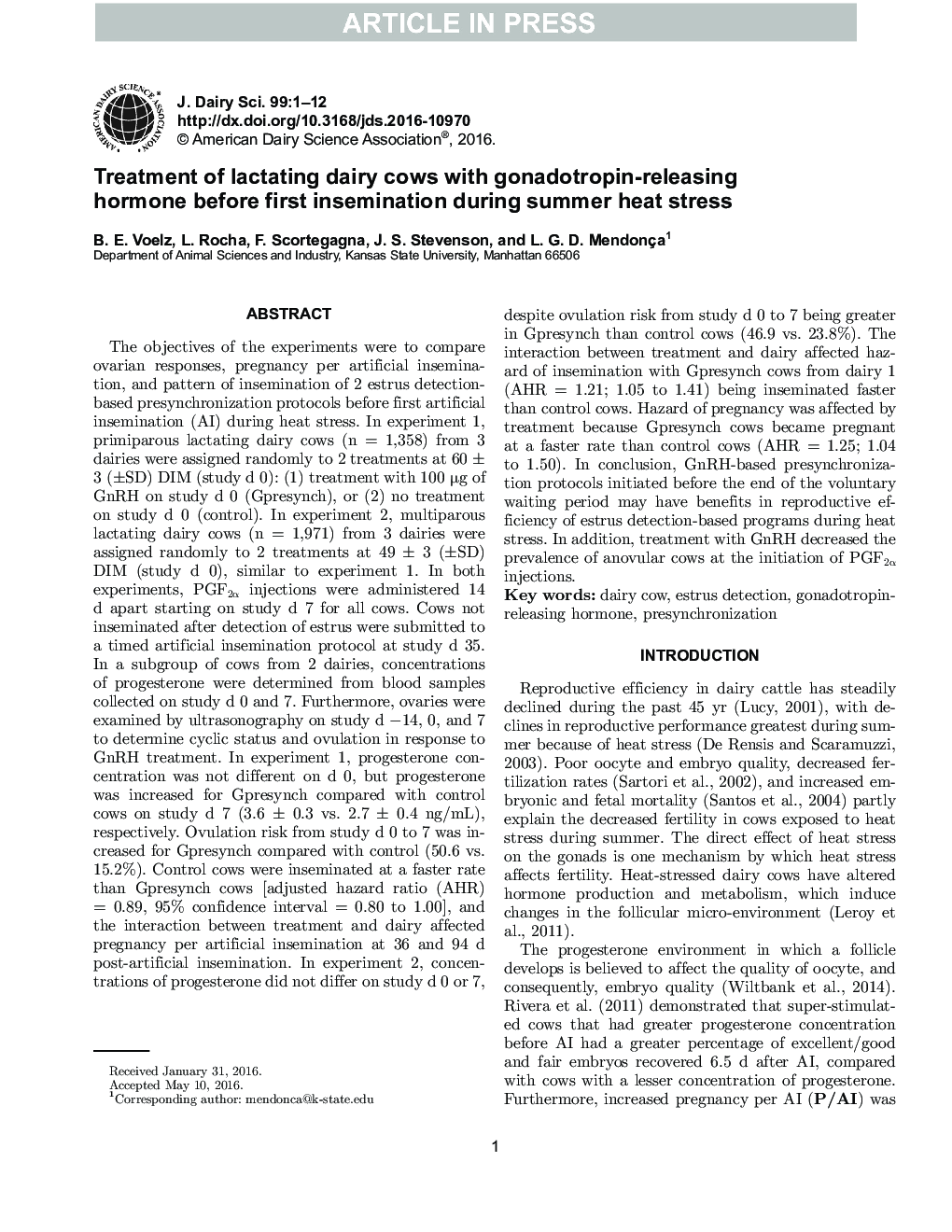| Article ID | Journal | Published Year | Pages | File Type |
|---|---|---|---|---|
| 5542867 | Journal of Dairy Science | 2016 | 12 Pages |
Abstract
The objectives of the experiments were to compare ovarian responses, pregnancy per artificial insemination, and pattern of insemination of 2 estrus detection-based presynchronization protocols before first artificial insemination (AI) during heat stress. In experiment 1, primiparous lactating dairy cows (n = 1,358) from 3 dairies were assigned randomly to 2 treatments at 60 ± 3 (±SD) DIM (study d 0): (1) treatment with 100 µg of GnRH on study d 0 (Gpresynch), or (2) no treatment on study d 0 (control). In experiment 2, multiparous lactating dairy cows (n = 1,971) from 3 dairies were assigned randomly to 2 treatments at 49 ± 3 (±SD) DIM (study d 0), similar to experiment 1. In both experiments, PGF2α injections were administered 14 d apart starting on study d 7 for all cows. Cows not inseminated after detection of estrus were submitted to a timed artificial insemination protocol at study d 35. In a subgroup of cows from 2 dairies, concentrations of progesterone were determined from blood samples collected on study d 0 and 7. Furthermore, ovaries were examined by ultrasonography on study d â14, 0, and 7 to determine cyclic status and ovulation in response to GnRH treatment. In experiment 1, progesterone concentration was not different on d 0, but progesterone was increased for Gpresynch compared with control cows on study d 7 (3.6 ± 0.3 vs. 2.7 ± 0.4 ng/mL), respectively. Ovulation risk from study d 0 to 7 was increased for Gpresynch compared with control (50.6 vs. 15.2%). Control cows were inseminated at a faster rate than Gpresynch cows [adjusted hazard ratio (AHR) = 0.89, 95% confidence interval = 0.80 to 1.00], and the interaction between treatment and dairy affected pregnancy per artificial insemination at 36 and 94 d post-artificial insemination. In experiment 2, concentrations of progesterone did not differ on study d 0 or 7, despite ovulation risk from study d 0 to 7 being greater in Gpresynch than control cows (46.9 vs. 23.8%). The interaction between treatment and dairy affected hazard of insemination with Gpresynch cows from dairy 1 (AHR = 1.21; 1.05 to 1.41) being inseminated faster than control cows. Hazard of pregnancy was affected by treatment because Gpresynch cows became pregnant at a faster rate than control cows (AHR = 1.25; 1.04 to 1.50). In conclusion, GnRH-based presynchronization protocols initiated before the end of the voluntary waiting period may have benefits in reproductive efficiency of estrus detection-based programs during heat stress. In addition, treatment with GnRH decreased the prevalence of anovular cows at the initiation of PGF2α injections.
Related Topics
Life Sciences
Agricultural and Biological Sciences
Animal Science and Zoology
Authors
B.E. Voelz, L. Rocha, F. Scortegagna, J.S. Stevenson, L.G.D. Mendonça,
